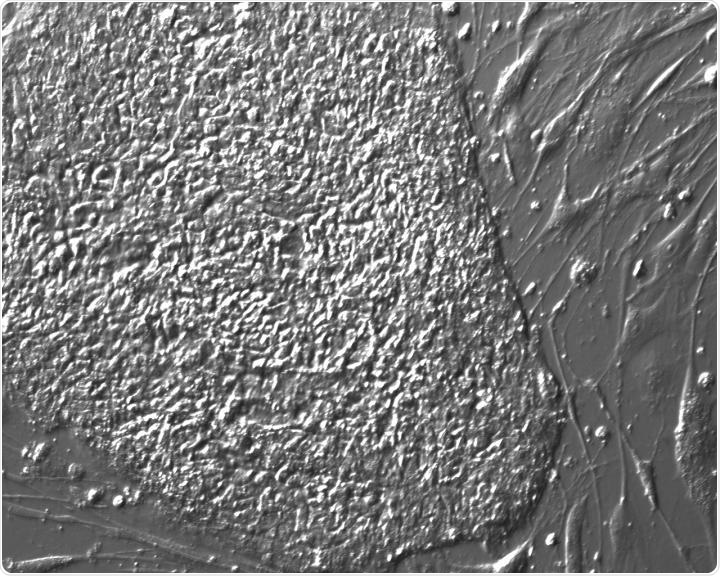Human pluripotent stem cells (hPSCs) show promise in the stream of regenerative medicine for how they lead to the fraction of every other type of cells in the body and for their potential to propagate endlessly.

Engineered Human Pluripotent Stem Cells. Image Credit: AlphaMed Press.
But the potential of hPSCs is impeded by the body’s tendency to reject any “allogeneic” tissue or cells, which implies that the cells originate from a donor other than the patient. Such a rejection is attributed to the immune system of the body that tags the cells as “foreign invaders” and triggers a range of strategies meant to prevent the so-called attack—leaving scientists looking for a way around this protective measure.
A new article, recently published in the STEM CELLS journal, describes a technique that may offer the answer. The study’s authors reported how they genetically edited out a major set of proteins present on the surface of the hPSCs. These proteins are the targets of immune rejection, primarily making them invisible to immune system of the body.
The multi-institutional research team was headed by Xiaoqing Zhang, MD, PhD, and Lin Ma, PhD, from the Tongji University School of Medicine.
What we have done is taken advantage of the non-classical human leukocyte antigen (HLA) molecules, which encode the main targets of allograft rejection, to construct hypoimmunogenic hPSCs. Our strategy not only ameliorates the body’s main immune-rejection weapons—T cells (especially CD8+ Ts), natural killer (NK) cells and antigen-presenting cells—but also attenuates cell contact-triggered cell killing and immunogenicity of the allograft environment.”
Xiaoqing Zhang, MD, PhD, Tongji University School of Medicine
The study grew out of the team’s understanding that the HLA-G family is one of the most conspicuously expressed HLA class I molecules in the placenta, and helps protect fetal tissue from the immune system of the mother.
Dr Zhang continued, “It’s a remarkable example of immune accommodation in mammals. So we engineered hPSCs using CRISPR/Cas9 gene-editing technology for beta-2 microglobulin (β2m) knock out, or for biallelic knock-in of HLA-G1 within the endogenous β2m loci.”
“Elimination of the surface expression of the HLA proteins protected the hPSCs from cytotoxicity mediated by the CD8+ T and NK cells. The lack of surface expression also resulted in missing-self recognition and aberrant NK cell activation.” Dr Zhang added.
The development of this method to shelter pluripotent stem cell derivatives from the immune system is a ‘game-changer’ in the field. If this innovative technique can next be carried forward to clinical trials it could mean that recipients of the cells would need no immune suppression. We are very happy to publish this novel and potentially paradigm-shifting research.”
Dr Jan Nolta, Editor-in-Chief , STEM CELLS
“To the best of our knowledge, this is the first study to report that engineered β2m- HLA-G5 proteins are soluble, secretable and can efficiently protect donor cells from immune responses. This not only provides a novel strategy to generate hypoimmunogenic human cells for allografting, but also sheds light on the role of HLA-G in immune tolerance during pregnancy and organ transplantation,” added Dr Ma.
According to both, the next stage will be to deal with safety concerns related to the engineered cells, including whether they carry a greater risk of growing tumors, considering their ability to evade immune surveillance.
Introducing a controllable suicide gene might provide an efficient way to remove the risk. If all goes well, the engineered hPSCs could serve as an unlimited cell source for generating universally compatible ‘off-the-shelf’ cell grafts in the future.”
Lin Ma, PhD, Tongji University School of Medicine
Source:
Journal reference:
Shi, L., et al. (2020) Generation of hypoimmunogenic human pluripotent stem cells via expression of membrane-bound and secreted β2m-HLA-G fusion proteins. Stem Cells. doi.org/10.1002/stem.3269.